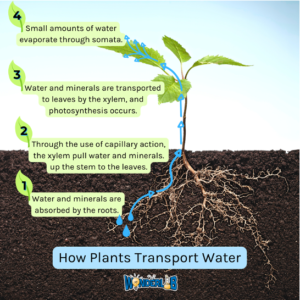What is capillary action?
One of the most exciting properties of water is known as capillary action. Capillary action occurs when water molecules travel up or across a surface because of their sticky nature. Water molecules are sticky due to a process called cohesion. The sticky nature of water means the molecules tend to grab onto each other and other surfaces. Many surfaces, including your paper flowers, are porous. This means the material has an irregular surface with spaces to which the water can adhere. When you place your paper flower into the water, water molecules adhere to the flower and “climb” up the paper pulling the water up from the base of the petal to the tip.
How do real flowers use capillary action?
Capillary action can be seen in many different aspects of our daily lives. Plants, including living flowers, utilize capillary action when pulling water to the leaves. Water from the ground is drawn through the roots and carried upward through the stem to the leaves with the help of the xylem. Xylem is a type of vascular tissue made of lignin and cellulose found in the stem to transport water and add support. This ability to carry water to a plant through capillary action is essential for the plant’s health. Flowers utilize water to create energy through a process called photosynthesis. Just like you and me, plants need water to provide nutrients and keep from becoming dehydrated!

Sources
Adhesion and Cohesion of Water | US Geological Survey. (2018, June 5). USGS. Retrieved March 4, 2022, from https://www.usgs.gov/special-topics/water-science-school/science/adhesion-and-cohesion-water
Capillary Action. (n.d.). Science World. Retrieved March 10, 2022, from https://www.scienceworld.ca/resource/capillary-action/
Capillary Action and Water. (2018, June 05). US Geological Survey. https://www.usgs.gov/special-topics/water-science-school/science/capillary-action-and-water
Hosch, W. L. (2016, September 16). Capillarity. Encyclopedia Britannica. Retrieved March 3, 2022, from https://www.britannica.com/science/capillarity
Petruzzello, M. (2022, February 18). Xylem. Encyclopedia Britannica. Retrieved March 10, 2022, from https://www.britannica.com/science/xylem
 About the Author: Kaitlyn Burress is a Development Intern at WonderLab. During the warm summer months, she can always be found in the garden. Kaitlyn is excited to share how flowers utilize capillary action every day!
About the Author: Kaitlyn Burress is a Development Intern at WonderLab. During the warm summer months, she can always be found in the garden. Kaitlyn is excited to share how flowers utilize capillary action every day!

Leave A Comment